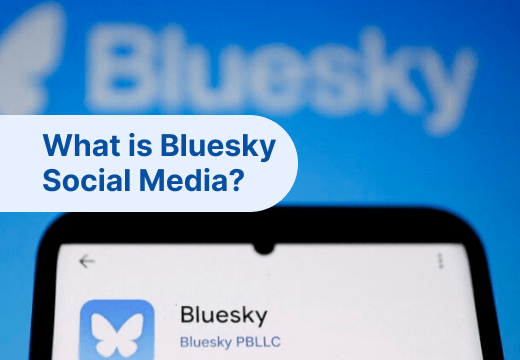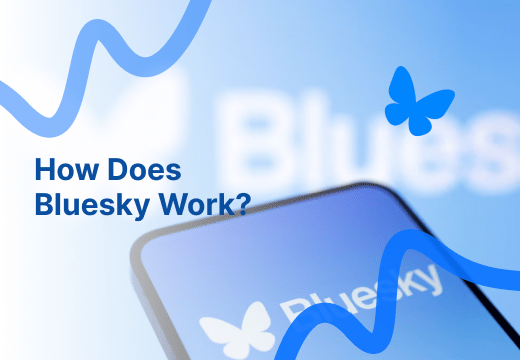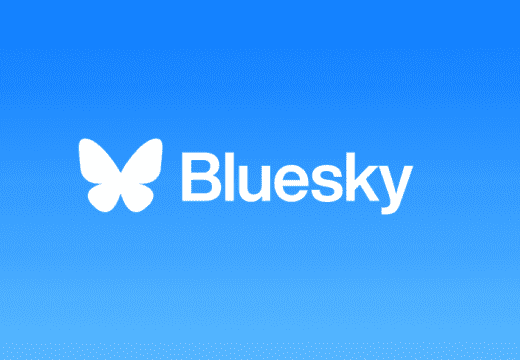Social media has significantly transformed how we communicate, connect, and share information. From the early days of MySpace and Friendster to the dominance of Facebook, Twitter, and Instagram, the landscape of social media has evolved rapidly. However, over time, users have increasingly voiced concerns over privacy, censorship, and the monopolistic control of tech giants over their personal data and online interactions.
In this context, Bluesky social media emerges as a decentralized alternative to the current centralized models, promising a fresh and innovative online interaction. Designed with privacy, freedom, and openness, Bluesky aims to disrupt traditional social media platforms by offering a decentralized, user-controlled ecosystem poised to change how we think about social media platforms.
In this blog article, we will explore Bluesky social media in-depth, looking at what makes it unique, how it works, and how it could potentially revolutionize the future of social networking. From its key features to its vision for the future, Bluesky is generating significant buzz and attracting interest from many users, especially those concerned with online privacy, security, and control.

1. What is Bluesky Social Media?
Bluesky is a decentralized social media platform originally conceptualized by Jack Dorsey, the co-founder of Twitter. Its goal is to foster a more user-centric, open, and decentralized social media ecosystem. Bluesky is designed to empower users and create a platform where individuals have greater control over their data and online interactions.
Background and Origin: Bluesky’s idea emerged from Twitter’s desire to create a less dependent platform on corporate ownership and centralized control. While Twitter has been immensely successful as a social media platform, Dorsey and others recognized the growing concerns around the concentration of power in a few large tech companies. The Bluesky project was conceived to address these concerns by offering a new, decentralized model for social networking.
At its core, Bluesky is designed to give users more freedom, privacy, and data ownership. The platform is open-source, meaning anyone can contribute to its development, and it operates using decentralized protocols that allow for more transparent and user-controlled interactions online.
The Mission of Bluesky: Bluesky’s mission is rooted in creating an open-source, decentralized network where users can share content and interact with others without the control of large corporations or governments. Bluesky hopes to create a more equitable and user-centric platform by leveraging decentralized protocols.
The platform’s primary goal is to shift the power dynamics in social media, putting more decision-making in the hands of users, not corporations. The vision is clear: to create an open, interoperable, and censorship-resistant social media experience that allows for greater user control and freedom.

2. Key Features of Bluesky
Bluesky offers several innovative features that distinguish it from traditional, centralized social media platforms. These features make the platform appealing to users who prioritize privacy, security, and a more open approach to social networking.
Decentralization: Unlike traditional platforms like Facebook, Instagram, and Twitter, which are governed by a centralized entity, Bluesky is based on a decentralized network. This means that no single organization or corporation owns or controls the platform. Instead, it operates through a network of independently run nodes or servers, each holding a portion of the platform’s data.
In a decentralized system, users have more control over their data and interactions, and the risk of data exploitation or censorship by a single entity is minimized.
Open Protocols (AT Protocol): Bluesky utilizes AT Protocol, a decentralized protocol designed to enhance interoperability between different applications. This protocol allows apps built on different servers to communicate with one another seamlessly, enabling greater data portability across platforms.
With AT Protocol, Bluesky offers a key advantage over traditional social media platforms. Users can move their data between different applications and services, allowing for a more flexible, user-controlled experience.
Data Ownership and Control: One of Bluesky’s standout features is its data ownership model. Unlike centralized platforms that control and monetize user data, Bluesky allows users to retain full ownership over their data, including content and digital identity. Users are in charge of what information they share and who they share it with.
The decentralized model means that users can opt out of data collection practices standard on other platforms, offering a more private, secure experience. Bluesky’s approach to data privacy aligns with the growing demand for greater transparency and user control in the digital age.
Interoperability: Bluesky’s use of decentralized protocols also allows it to interact with other networks and platforms, unlike traditional social media systems that operate in silos. By encouraging interoperability, Bluesky will enable users to connect with individuals and communities across different platforms, breaking down the walled-garden approach that traditionally defines social media.
Content Moderation: One of the most controversial aspects of traditional social media platforms is their approach to content moderation. Bluesky offers a more user-driven model for content moderation, where individual communities and servers can establish acceptable content rules.
By decentralizing content moderation, Bluesky ensures that no single entity or corporation has the power to impose its values on the entire platform. This could lead to greater freedom of expression while empowering communities to manage their moderation practices in a way that aligns with their values.
User Interface: Bluesky’s user interface is designed to be familiar yet innovative. It includes features commonly found on traditional platforms, such as status updates, followers, likes, and comments, but with a greater emphasis on user control and data privacy.
Although the interface is still evolving, early users have reported a clean, intuitive experience that feels familiar to anyone who has used social media before, making the platform easy to adopt.

3. How Does Bluesky Work?
Bluesky’s decentralized architecture plays a critical role in how the platform operates, and it is one of the primary differentiators between it and traditional social media. Let’s take a closer look at how Bluesky works:
The Decentralized Nature: Bluesky’s decentralized nature means it doesn’t rely on a single centralized server or entity to store or control its data. Instead, Bluesky operates as a peer-to-peer network where users control their interactions. This gives Bluesky a more resilient and secure structure, as no single point of failure can compromise the platform.
Bluesky also ensures that a central authority can’t censor or manipulate content. This open structure promotes freedom of speech and protects users from censorship or bias.
The Role of AT Protocol: The AT Protocol is the backbone of Bluesky’s decentralized architecture. It allows different apps and services to interact, enabling users to move between platforms seamlessly. This protocol offers greater data portability, allowing users to take their data anywhere.
The protocol also ensures that data privacy and security remain prioritized in the decentralized environment, offering a transparent system that keeps user information safe from exploitation.
Bluesky’s Architecture: Bluesky’s architecture is designed to be open, transparent, and collaborative. Bluesky allows developers to contribute to the codebase as an open-source platform, ensuring that the platform evolves according to the community’s needs. This open development model means that Bluesky is more agile and responsive to user feedback than traditional, proprietary platforms.

4. How to Join Bluesky Social Media
Bluesky operates on an invitation-only model, meaning users must receive an invite to join the platform. This model ensures that early adopters are enthusiastic and invested in the platform’s decentralized mission.
Invitation-Only Model: To join Bluesky, users need an invite from an existing member. This model helps control growth, ensuring that users who join the platform are genuinely interested in its decentralization and user empowerment mission.
Account Setup Process: Once an invite is received, setting up an account on Bluesky is straightforward. Users can create a profile, upload content, follow others, and start engaging with the community. The platform’s user interface is designed to be familiar to anyone who has used social media before, ensuring a smooth onboarding process.
User Experience Expectations: Bluesky offers new users a refreshing and empowering experience. Users have greater control over their data, their privacy settings, and the content they interact with. The decentralized nature of the platform fosters a sense of community and collaboration, where users have a greater voice in the platform’s development and policies.

5. Advantages of Bluesky Over Traditional Social Media
Bluesky offers several key advantages over traditional social media platforms, which have become notorious for their privacy, censorship, and data exploitation issues.
Privacy and Security: Bluesky’s decentralized model offers a significant privacy advantage over traditional social media platforms. Users retain complete control over their data, ensuring it is not sold or monetized by third parties. Bluesky’s use of open protocols and data ownership puts the power back into the hands of users, ensuring a more secure and private experience.
Reduced Censorship: Bluesky’s decentralized nature makes it less susceptible to the censorship practices standard on centralized platforms. Users have greater freedom to express themselves without fear of arbitrary content removal or account suspension by a central authority.
Transparency and Open Source: Bluesky is built on open-source technology, making it more transparent than proprietary platforms. Users and developers can see how the platform is built and contribute to its development, fostering a sense of trust and community.
Community Control: Bluesky gives users more control over their experiences by allowing individual communities to set content moderation rules. This level of customization ensures that users can participate in communities that align with their values and interests.
6. Challenges Facing Bluesky
Despite its many advantages, Bluesky faces several challenges that it must overcome to succeed in the competitive social media landscape:
Adoption and Growth: One of the biggest challenges Bluesky faces is convincing users to switch from established platforms like Twitter and Facebook. Traditional platforms have a massive user base and an established presence in the digital world, making it difficult for new platforms like Bluesky to attract and retain users.
Scalability Issues: Decentralized platforms often struggle with scaling to accommodate large numbers of users. Bluesky must address infrastructure and data management issues as it grows to ensure the platform remains reliable and user-friendly.
Security Risks: While decentralization can enhance security, it also poses risks. Bluesky must ensure that its decentralized infrastructure is secure from cyberattacks and that users’ data is protected across the network.
Content Moderation: The greatest challenge for decentralized platforms is finding the right balance between free speech and harmful content. Bluesky’s user-driven approach to content moderation could lead to inconsistent policies and practices across different communities.

7. How Bluesky Affects the Future of Social Media
Bluesky is more than just a new social media platform – it represents a shift in how we think about social media and the internet. Here’s how Bluesky could shape the future of social media:
Impact on Content Creators: Bluesky’s decentralized nature empowers content creators, allowing them to maintain ownership of their content and interact directly with their audiences. This opens up new business models for creators and offers greater freedom in sharing and monetizing their work.
Shift Toward Open Standards: Bluesky’s open-source, decentralized approach could inspire other social platforms to adopt open standards, paving the way for a more open, user-controlled internet.
New Business Models: Bluesky may introduce new business models prioritizing user privacy, data ownership, and community-driven governance. Brands and marketers may need to adapt to this new model, focusing on more authentic and transparent user interactions.
Governments and Regulation: As decentralized platforms grow, governments will face new challenges in regulating them. Bluesky’s decentralized nature may prompt governments to rethink existing laws and policies on social media content moderation, data privacy, and user rights.

8. Current Popularity and User Base
Bluesky’s user base is still growing, but early adopters, including privacy advocates, tech enthusiasts, and content creators, have shown significant interest in the platform. While its user base is smaller than that of Twitter or Facebook, Bluesky’s focus on privacy, freedom, and decentralization has attracted a dedicated group of users eager for a new, user-centric social media platform.
9. Comparing Bluesky to Other Platforms
Bluesky’s unique decentralized approach distinguishes it from traditional social media giants like Twitter, Facebook, and Instagram. Here’s how Bluesky compares to other platforms:
Bluesky vs. Twitter: Bluesky builds on lessons from Twitter, offering a decentralized alternative with greater data privacy and user control. Unlike Twitter, which is controlled by a central authority, Bluesky allows communities to set rules and policies.
Bluesky vs. Mastodon: While Mastodon is another decentralized platform, Bluesky offers a more streamlined user experience and a focus on interoperability across different platforms.
Bluesky vs. Facebook/Instagram: Unlike Facebook and Instagram, which prioritize advertising revenue, Bluesky prioritizes data ownership, privacy, and freedom of expression, making it an appealing alternative for users concerned about censorship and data exploitation.

10. The Future of Bluesky
Bluesky is still in its early stages, but the platform has significant potential for growth and expansion. As it develops, we can expect to see new features, improvements in user experience, and more integrations with other decentralized platforms.
Plans for Improvement and Expansion: Bluesky’s development roadmap includes expanding its features, improving its user interface, and enhancing its scalability to accommodate a larger user base.
Innovations to Watch For: Key innovations to watch for include improvements in interoperability, new content moderation tools, and expanded options for content creators.
Bluesky’s Role in the Decentralized Web Movement: Bluesky plays a crucial role in the larger Web 3.0 movement, which seeks to create a more decentralized, user-controlled internet. As more platforms adopt decentralized protocols, we could see a shift from centralized systems toward a more open, transparent, and user-driven internet.
Bluesky represents a promising evolution in social media. Its decentralized approach, focus on privacy, and user-centric model offer a fresh alternative to the centralized platforms that dominate the digital landscape. While it faces challenges related to adoption, scalability, and security, its unique features and commitment to open-source development make it a platform worth watching.
As social media continues to evolve, Bluesky’s emphasis on decentralization and user control could be the blueprint for the next generation of social networking platforms. The future of social media is changing, and Bluesky could play a key role in shaping that future.
Are you ready to explore Bluesky and grow your business through new social media? Contact SMM Tigger, a data-driven digital marketing agency, to harness the power of Bluesky Social Media and elevate your online presence. We help businesses of all sizes build custom strategies to grow, engage, and succeed digitally.

11. How to Use Bluesky Social Media for Online Business
Bluesky is not only for individuals looking to connect and share; it also offers tremendous potential for businesses looking to expand their online presence. Whether you are a small business, a startup, or a large corporation, Bluesky Social Media can be an effective tool for building brand awareness, engaging with customers, and growing your business. Here’s how you can use Bluesky for online business.
Creating a Business Account: Before you start engaging with users and promoting your brand, you must set up a business account on Bluesky. Like any other social platform, a professional presence is key to making an impact.
- Setting up your profile: Your business profile should clearly communicate your brand’s message. Choose a recognizable logo and ensure your business name is easy to find. Include relevant details like your business website, contact information, and a clear description of your products or services.
- Branding and Design: Think about how you want your business to be perceived. Bluesky offers various customization options, so take the time to design a profile that aligns with your branding. Consistency across platforms is crucial for building recognition and trust.
Content Strategy: Content is king, even on Bluesky Social Media. To stand out, it’s important to create content that resonates with your audience.
- Types of content that resonate: Bluesky is known for short-form, media-rich posts. Utilize images, videos, and infographics to make your posts more engaging. Share behind-the-scenes content, product launches, or user testimonials to connect with your audience.
- Best practices for engagement: Just like on other social media platforms, interaction is key. Respond to comments, engage in conversations, and like or share content from your followers. The more you interact, the more visibility your posts will get.
- Hashtags: Bluesky utilizes hashtags, just like Twitter and Instagram. Use relevant hashtags to help your posts reach a broader audience and increase visibility.
Building a Community: Building a strong community is even more important in a decentralized social media network. With Bluesky, your followers are not just numbers but engaged users with a say in the platform’s content and direction.
- Fostering relationships: To build a loyal following, you must create relationships with your audience. Share valuable content, interact regularly, and show appreciation for your followers. The more genuine your engagement, the stronger your community will be.
- Joining relevant groups: One of Bluesky’s open network features is its ability to connect users with like-minded groups. As a business, you can join relevant discussions or groups related to your industry to expand your reach and build authority.
Advertising on Bluesky: Bluesky Social Media does not offer traditional advertising options like Facebook or Instagram. However, this could change as the platform grows. Until then, businesses must rely on organic methods to reach their audience.
- Organic reach: The beauty of Bluesky’s decentralized nature is that it emphasizes organic content. Creating valuable content and engaging with your followers allows you to gain visibility without relying on paid ads.
- Community-driven promotion: Since Bluesky is a platform that encourages open participation, it’s crucial to leverage user-generated content. Encourage your followers to share their experiences with your brand, and give them a reason to help spread the word.
Measuring Success: Like any other social media platform, measuring success on Bluesky is essential to track your business’s growth.
- Key performance indicators (KPIs): Some critical KPIs to track include engagement rate (likes, replies, shares), follower growth, and content reach. By monitoring these metrics, you can assess how well your content is performing and make necessary adjustments.
- Tools for analysis: Bluesky is still evolving, and the analytics tools may not be as robust as other platforms. However, third-party tools like Google Analytics and social media management platforms can be used to track engagement and measure success.
Adapting Strategies Based on Feedback: Being adaptable is the key to success on any social media platform. As Bluesky continues to grow, user behaviors and trends will shift. Stay flexible, monitor your performance metrics, and adjust your content and strategy accordingly.
12. Social Media Tools to Enhance Your Bluesky Strategy
Buffer: Buffer is a powerful tool for scheduling posts, managing multiple social media accounts, and analyzing performance. It can benefit businesses on Bluesky, helping you schedule and optimize posts across different platforms and ensuring you reach your audience at the right time.
HubSpot: HubSpot is an all-in-one marketing platform that offers tools for social media management, email marketing, and lead generation. Using HubSpot, businesses can integrate their Bluesky strategy with a broader inbound marketing approach, building customer relationships and driving conversions.
Hootsuite: Hootsuite is another excellent social media management tool that can help businesses manage multiple Bluesky accounts. It allows businesses to track engagement and gain insights, helping them adjust their content strategy to increase follower engagement and grow their brand presence.
Canva: Canva is an online graphic design tool that simplifies the process of creating visually appealing content for Bluesky. With Canva, businesses can design eye-catching images and graphics that enhance their posts, making them more engaging for Bluesky’s audience.
Bluesky represents a promising evolution in social media. Its decentralized approach, focus on privacy, and user-centric model offer a fresh alternative to the centralized platforms that dominate the digital landscape. While it faces challenges related to adoption, scalability, and security, its unique features and commitment to open-source development make it a platform worth watching.
As social media continues to evolve, Bluesky’s emphasis on decentralization and user control could be the blueprint for the next generation of social networking platforms. The future of social media is changing, and Bluesky could play a key role in shaping that future.
Are you ready to explore Bluesky and grow your business through new social media? Contact SMM Tigger, a data-driven digital marketing agency, to harness the power of Bluesky Social Media and elevate your online presence. We help businesses of all sizes build custom strategies to grow, engage, and succeed digitally.

